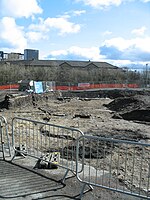River Kelvin

The River Kelvin (Scottish Gaelic: Abhainn Cheilbhinn) is a tributary of the River Clyde in northern and northeastern Glasgow, Scotland. It rises on the moor south east of the village of Banton, east of Kilsyth. At almost 22 miles (35 km) long, it initially flows south to Dullatur Bog where it falls into a man made trench and takes a ninety degree turn flowing west through Strathkelvin and along the northern boundary of the bog parallel with the Forth and Clyde Canal. The University of Glasgow is situated by the river, in Gilmorehill. In 1892, the title of Baron Kelvin was created for physicist and engineer William Thomson, a professor at the university. The name "kelvin" for the unit of temperature, chosen in honour of Lord Kelvin, thus traces its origins to the river.
Excerpt from the Wikipedia article River Kelvin (License: CC BY-SA 3.0, Authors, Images).River Kelvin
Govan-Partick Bridge, Glasgow Partick
Geographical coordinates (GPS) Address Nearby Places Show on map
Geographical coordinates (GPS)
| Latitude | Longitude |
|---|---|
| N 55.86518 ° | E -4.30815 ° |
Address
Govan-Partick Bridge
Govan-Partick Bridge
G3 8RS Glasgow, Partick
Scotland, United Kingdom
Open on Google Maps







